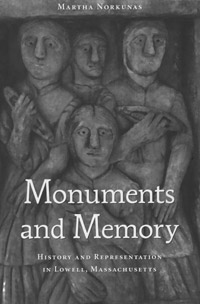Book Review
Monuments and Memory: History and Representation in Lowell, Massachusetts
By Martha Norkunas. Washington, DC, and London: Smithsonian Institution Press, 2002; xi + 208 pp., illustrations, appendices, notes, bibliography, index; cloth $39.95; paper $17.95.
 |
In recent years, memory and its complex relationships to history has garnered increasing intellectual attention. Martha Norkunas's Monuments and Memory: History and Representation in Lowell, Massachusetts adds to our understanding of these relationships as history, histories, and memories have been formed and re-formed in this milltown turned national park. In a series of interrelated essays, Norkunas successfully tackles questions "about the connections between gender, ethnicity, power, space, and narrative, about the relationship between the living and the memory of the dead, and about the uncertain intersections between memory and history."
Building on her personal ethnic history and her deep connections to Lowell, Norkunas began a systematic documentation of Lowell's 252 monuments. She sought to make sense of their origins and significance, and to contrast her female-centered family's narratives with the public memorials' "sea of maleness." In the process she describes a continuum from personal memory to national history, from her personal life to a national park. Some of the most interesting reading comes with her developing an understanding of her family's past: "I could not go in. I was afraid that my memory of the past which I had varnished over time…would be forever disturbed."
For much of the book, Norkunas wrestled with issues of significance—how it changes with generations and as direct knowledge of those being remembered fade. Norkunas shows memory not as a finished event but as an ongoing process between the people being remembered and those doing the act of remembering. Memory is process changed by those individuals and communities participating in it. Many of Lowell's memorials had become unrecognized—drained of their original meaning. Others, originally dedicated to individuals, take on different significance as ethnic neighborhood boundary markers.
In her chapter "The Gender of Memory," she particularly honors the private women's history: "It often seemed to me that these stories, the ones that were told openly and the ones that were told in hushed tones, were the real history of Lowell, the history that mattered, and that only the women knew it." She states, "For women the site of memory, the place where the living and the dead commingle, is not on the landscape but remains rooted in the narrative." She concludes that women are "rememberers of male accomplishment," but not themselves remembered. She hints that as women enter more public spheres their recognition through monuments will increase.
Norkunas raises several issues for those of us involved in cultural resources to consider. Highlighted are the competing visions between parks created to promoted local values (here, ethnic ones) or to provide a stable economy through enticing newcomers (here, white collar jobs). Patrick Mogan, Lowell's School Superintendent and "Father of Lowell NHP," used the local approach; U.S. Senator Paul Tsongas focused on economic incentives. One approach risks not being the truly national story Congress intends when it establishes such parks. The other risks creating something so gentrified as to lose its roots in reality.
According to Norkunas, the area's focus on the mill girls had not gotten "more than a passing local interest…prior to the advent of the National Park." Given the extensive historical literature on Lowell's early industrialization and its famous mill girls, Norkunas's statement reflects more local and temporal attitudes than a Nation's history. Gradually, the park's significance expanded to a larger (and longer) story of immigrant generations of mill workers, from the Irish digging the mills' canals to the post-mill era Cambodians who by 1990 made up 25 percent of Lowell's population. At Lowell, these histories—of mill girls long gone and of immigrant generations still very present—can either compete or, preferably, be seen as complementary. Her insights into the tensions between these approaches are useful to many other places.
The book assumes some knowledge about Lowell as a city and as a national park. Maps showing the succession of ethnic communities and key monuments would have been helpful. She could have pushed some of her thoughts further, particularly concerning how becoming a national park shifts local history and memory.
Monuments and Memory is recommended for those interested in better understanding relationships between communities and national parks, for those responsible for commemorative works, and for anyone interested in the interplay between memory and history. Norkunas concludes that, "History texts do not begin when memory ceases to function, as the cultural theorists suggested; rather history coexists, side by side, with a living, functioning memory."
Heather Huyck
National Park Service
